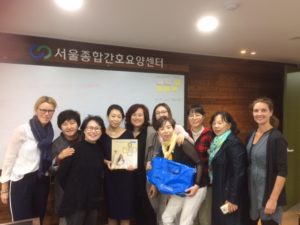South Korea is the fastest ageing country is Asia and introduced a Long Term Care Insurance (LTIC) based on the Japanese model in 2008. However most of the funds go into home care and only a very small part (0,3%) go into home nursing. Home nursing is underdeveloped, also it’s cheaper for the family (lower co-payment) to send an elderly into hospital than having medical care at home. The care is fragmented because there are 3 separated services (home care, bathing care and home nursing) provided by different service providers. South Korea National Health Insurance (NHIS) understand the need for action and strive to set up integrated, community-based service models.
Based on first meetings during the visit of the Dutch Royal Couple in Seoul in October 2014 numerous meetings has been set up with NHIS, LTCI, KVNA (Korean Visiting Nurse association), the city of Seoul and other stakeholders and created a lot of awareness for Buurtzorg. Buurtzorg also facilitated an intensive experience exchange with in either Japan as in Holland. An innovative nurse station and the KVNA as a partner was identified. A MoU was signed (May 16th 2016) and agreed to participate in a “Community-based integrated care” project.
Buurtzorg and KVNA agreed to join forces to build a platform to facilitate aging in place in Korea by leveraging and further developing the Dutch Buurtzorg model for the Korean situation. Since October 2016 there have been several meetings and workshops in Seoul by a Buurtzorg community nurse and a Buurtzorg coach.
In order to implement Buurtzorg, Korea is facing different challenges just like other Asian countries. Home nursing is not that well known as in the Netherlands, the role of the community nurse does not exist, there is a lack of care infrastructure in communities, nurses are used to work in hierarchical settings and follow orders instead of finding solutions and deciding for themselves, nurses do not perform ADL work and have a lower level of responsibility in the team. So while we use the core ideas of the Buurtzorg concept as a base, there is a need to adapt the model to the local needs.
During the first Annual Conference of the KVNA in January 2017, 10 nurse stations were identified to pilot this new way of working toward more integrated care for the coming 6-9 months. In March was the follow-up and 10 CEO’s and visiting nurses attend a 2 day training/workshop as a kick-off of the pilot. The objectives were to explore the feasibility of integrated community care based on the Buurtzorg model, identify solutions and a possible path for a full roll-out, understanding the need of the nurses and what is needed to attract, retain and train nurses for the home nursing sector. A part of this project will be an exploration trip to the Netherlands planned for June 2017.
